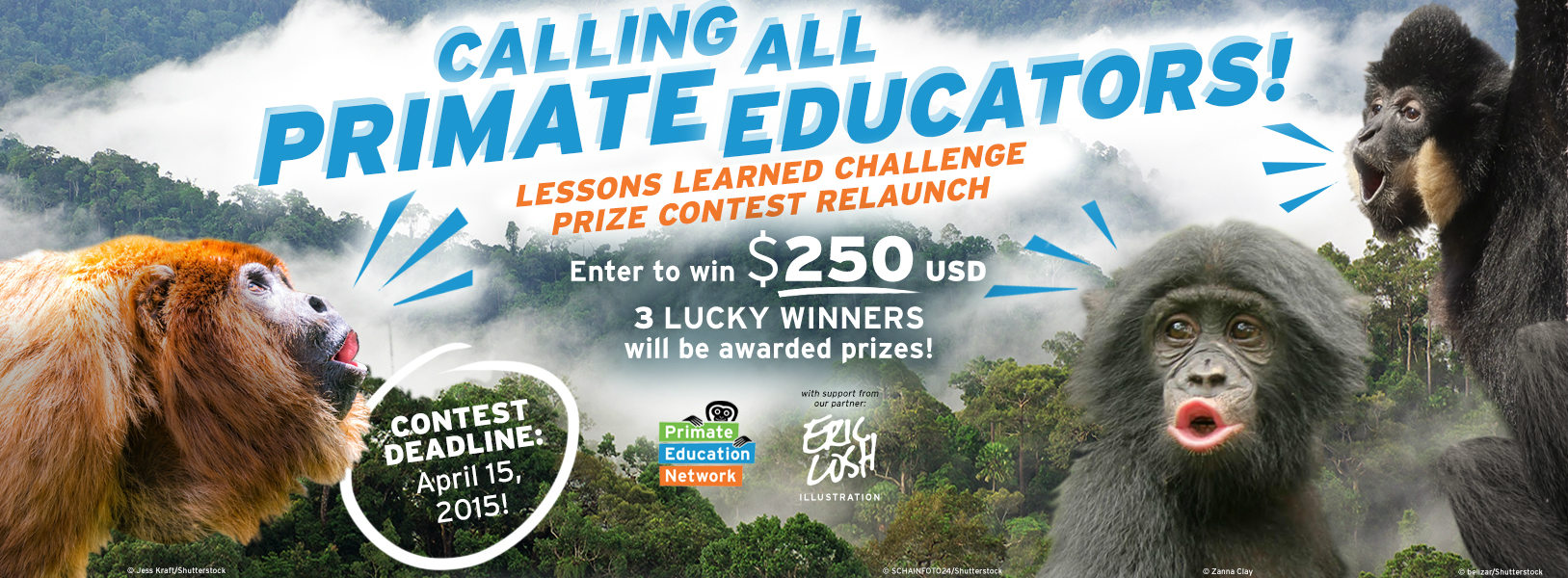PEN’s 2014 Global Survey revealed educators’ greatest challenge (sharing lessons learned) and need (funding). We listened to our colleagues and responded quickly with our Lessons Learned Challenge Prize Contest as a solution (with support from Eric Losh Illustration). Based on our members' feedback, we are relaunching our contest with a simplified three-question format to encourage more educators to participate.
The purpose of PEN's contest is to collect and curate lessons learned and provide funding to three organizations working in Latin America, Africa, and Asia. Educators and practitioners will benefit from the results of our contest by learning from each other’s experiences about what works or does not work in the field. They will avoid wasting time on approaches that have already proven to be ineffective. Similarly, they will learn about what works well and how to implement the most effective strategies.
Contest Details:
- Contest Deadline: All submissions must be received by April 15, 2015. We will e-mail the finalists and announce the winners by May 15, 2015.
- Eligibility: To be eligible for PEN’s Challenge Prize, you must become a PEN member.
- Cash Prizes: PEN will select three prize finalists. Each finalist will receive $250 USD.
Looking for inspiration? Read three examples of challenges on a range of issues in primate education. To participate in our contest, please submit your responses using our new application form below.
If awarded a prize, you must agree to register on PEN’s Projects Directory, commit to spending your prize on items benefiting your primate education efforts, share photos and submit a blog on your activities, and participate in PEN’s follow up impact survey.
Examples of Challenges, Solutions, & Lessons Learned in Primate Education
Challenge #1
Name: Fanny M. Cornejo
Organization / Institution: Yunkawasi
Country: Peru
Adapted from Fanny’s Voices from the Field interview with PEN.
1. Please describe a specific challenge or problem in primate conservation education that you/your organization have experienced.
As a Research Coordinator with Yunkawasi, I co-designed a long-term primate conservation education program in Peru’s Tropical Andes, reaching over 10,000 schoolchildren from rural areas.
Working on primate education in rural areas is a challenge on its own, but the biggest challenge that my organization has encountered is funding. Since funders like quantifiable evidence on how the project is succeeding (e.g. through attitudinal and behavioral change), it is challenging to measure and explain this process of evaluation and impact, especially if you’re developing a new education program.
2. Did you solve this challenge or problem? What was your solution?
In 2008, when we started our education program, it was very difficult for us to secure funds. At the beginning, we were only successful in obtaining small grants and including the educational component as part of larger grants for the organization.
Once we were able to show concrete evidence of our success and impact as our program grew, we solved our challenge by securing new sources of revenue through local authorities, political parties, NGOs, and individuals, who expressed interest in supporting our work and helping us expand our reach. For example, some people donated materials for our drawing contests, including colored pencils and paper. Involving local stakeholders in our fundraising efforts gave them a sense of ownership in our conservation efforts.
3. What did you learn from your experience? Do you have any recommendations to share that would help fellow educators avoid your problem or repeat your success?
By gaining support through local stakeholders, expanding our education efforts, and showcasing our success in changing attitudes and behaviors of local schoolchildren and communities, my organization was able to get larger sources of funding for our education efforts. I learned that this process takes time and patience. My recommendation for fellow educators is to be creative and look for novel (or non-traditional) ways of getting funding, especially in the beginning stages of your program.
Challenge #2
Name: Xyomara Carretero-Pinzón
Organization / Institution: Zocay Project
Country: Colombia
Adapted from Xyomara’s Case Study Challenge group discussion at PEN’s training workshop in Colombia.
1. Please describe a specific challenge or problem in primate conservation education that you/your organization have experienced.
I conduct my project in private farms dedicated to cattle ranching. My research is focused on evaluating the effects of fragmentation on primate species, including the endemic dusty titi monkey. I have organized meetings with the farmers and developed some informal educational activities with the children at the farms, but the houses in the area are far apart. Reaching and educating farmers and their families, whose homes are widely dispersed in my primate study region, is challenging. I have to travel house-to-house, but this takes a significant amount of time and financial resources to support my transport, materials, and supplies.
2. Did you solve this challenge or problem? What was your solution?
I have not solved my challenge. With limited resources and time, I have to visit each farm and spend time with them to learn about their beliefs, attitudes, and needs, in order to understand how I can improve the design of my educational activities to increase their knowledge and inspire behavior change to protect primates.
3. What did you learn from your experience? Do you have any recommendations to share that would help fellow educators avoid your problem or repeat your success?
Originally, I learned to accept my challenge as is and would have recommended to fellow educators that the small changes over time make it all worth it. But last year, I was given a platform to share my challenge at PEN’s two-day training workshop on primate education in Colombia. My colleagues proposed the following three solutions during our Case Study Challenge group discussion:
1. Arrange community lunches, incorporating primate conservation education activities.
2. Organize a soccer championship with a monkey theme.
3. Host a family cinema night, featuring films with conservation messages.
During the workshop, I learned the importance of collaborating with other educators to solve challenges in primate education. I highly recommend sharing your problems and solutions with fellow educators. There’s no point in reinventing the wheel. I also learned that I should try another more far-reaching approach to education by hosting attractive events that bring the whole community together.
Challenge #3
Name: Amanda Korstens
Organization / Institution: Bournemouth University, U.K.
Country: The Gambia
Adapted from Amanda’s Case Study Challenge group discussion at PEN’s workshop during the 2014 Int’l Primatological Society Congress in Vietnam.
1. Please describe a specific challenge or problem in primate conservation education that you/your organization have experienced.
My field site is a local forest by the beach in The Gambia. It is a location where tourists come in great numbers every year during the tourist season. Tourism is the main source of income (apart from peanut exports, but due to the changing climate, crops are failing regularly). There are two main types of tourists: the bird watchers (who may be slightly easier to educate) and the beach tourists (who will be harder to convince).
My challenge is two-fold. Firstly, the local people generate income by selling peanuts to the tourists to feed the monkeys. Secondly, the tourists like the experience of being able to touch and get close to the monkeys. The problem is that we have already identified a potentially human-primate transmitted disease in the population and it is urgent that we spread conservation messaging in the area.
I am in the process of designing a program to educate the local community, tourists, guides, and park staff about not feeding monkeys. I want my education program to increase the knowledge of local guides and park staff to improve the tourist experience when visiting the park and remove the monkey-feeding experience.
2. Did you solve this challenge or problem? What was your solution?
I have not started my education program, so I have not solved the problem. However, Cumbria University staff and students have organised the placement of a large educational sign at the forest entrance that conveys feeding the monkeys is harmful. This approach is not working, as I recently visited the site and the monkeys are still being fed daily and the rules are not enforced. Park officials are aware of the urgency of the situation and claim to understand the problem, but it is not actually making a difference yet.
3. What did you learn from your experience? Do you have any recommendations to share that would help fellow educators avoid your problem or repeat your success?
Although I had not yet solved my problem, I was able to brainstorm ideas with colleagues at PEN’s workshop during the 2014 Int’l Primatological Society Congress in Vietnam during our Case Study Challenge group discussion. My colleagues proposed the following solutions:
1. Initiate guide-training courses that would lead to accreditation and equip them with badges (as part of an official guide association) to increase their status (A three-day training was advised with at least one follow up after six months. By giving guides an official status, they will have more “power” to act and control non-authorized guides.)
2. Identify alternative livelihoods for the peanut vendors outside the national park (e.g. crafts)
3. Increase awareness about biting risks and disease transmission (This has to be done carefully as it could lead to lethal backlash on primates due to people’s increased fear of disease.)
4. Create a feeding station that could be managed by the trained guides, who would feed the monkeys the right food items and use the opportunity to educate visitors
5. Explain to tourists and local people involved that it is good health and safety practice not to touch wild animals (If the tourists do not touch the primates, this will reduce the monkeys’ interest in the tourists.)
6. Craft a positive message (e.g. 90% of the tourists are responsible compared to 10% that are irresponsible. Which one do you want to be?)
7. Use photos and clear, simple messages on boards with green ticks for good human-wildlife interactions and red crosses for bad human-wildlife interactions
8. Ensure tourists are informed in the hotels








